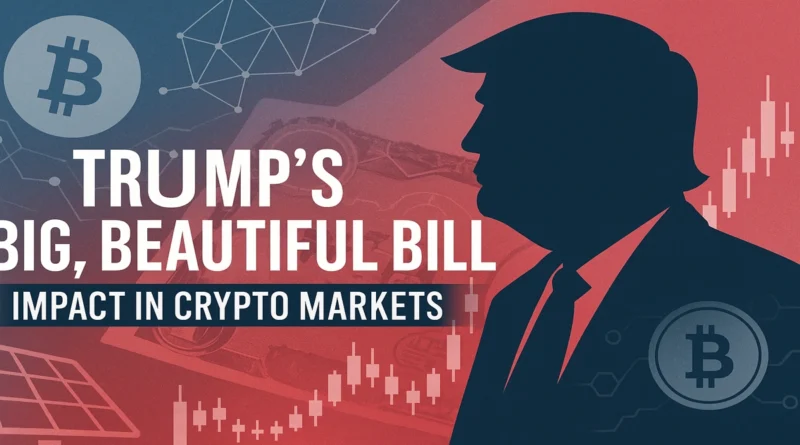Trump’s Big Beautiful Bill: How It Impacts Crypto Markets in 2025
On July 4, 2025, President Donald Trump signed the One Big Beautiful Bill Act into law, a sweeping piece of legislation that’s making waves across the U.S. economy. While the bill focuses on tax cuts, border security, defence spending, and social program reforms, it has no direct provisions for cryptocurrencies. Yet, its economic ripple effects could significantly influence the crypto markets, particularly Bitcoin, Ethereum, and other major digital assets. As an experienced crypto enthusiast, I’ve dug into the details to explore how this bill might impact the volatile world of cryptocurrencies, drawing from recent analyses and market insights.
In this article, we’ll break down the Big Beautiful Bill, its economic implications, and what it means for crypto investors. Whether you’re a seasoned trader or just dipping your toes into digital assets, this guide will help you understand the potential opportunities and risks ahead.
Table of Contents
What Is the Big Beautiful Bill?
The Big Beautiful Bill, officially known as H.R.1 in the 119th Congress (2025-2026), is a landmark piece of legislation that extends the 2017 Tax Cuts and Jobs Act, boosts spending on border security and defence, and makes significant cuts to social programs like Medicaid and SNAP. Signed into law after passing the House on July 3, 2025, the bill is projected to add over $3 trillion to the U.S. national debt over the next decade, according to CBS News.
Key components include:
- Permanent Tax Cuts: Extends the 2017 tax reductions, favouring high earners and corporations.
- Tax Write-Offs: Introduces deductions for tips (up to $25,000 annually) and overtime pay (up to $12,500).
- Spending Increases: Allocates $300 billion for border security and defence.
- Social Program Cuts: Reduces funding for Medicaid by $1 trillion, among other program trims.
While the bill doesn’t directly mention cryptocurrencies, its economic fallout—particularly the massive debt increase—could create a fertile environment for digital assets. Let’s explore how.
Economic Ripple Effects: Inflation and Crypto as a Hedge
The Big Beautiful Bill’s most significant impact on crypto markets lies in its potential to drive inflation. By adding $3 trillion to the national debt, the bill may force the U.S. government to print more money, a move that often devalues fiat currencies and sparks inflationary pressures. For crypto investors, this is where things get interesting.
Bitcoin, often dubbed “digital gold,” has long been viewed as a hedge against inflation due to its capped supply of 21 million coins. As noted in a Cointelegraph article, market observers are optimistic about Bitcoin’s long-term prospects under these conditions. A tweet from crypto analyst Rananjay Singh (@TodayCryptoRj, July 4, 2025) sums it up: “More debt can lead to more money printing. That’s good for $BTC in the long run but price may go up and down in the short term.”
This sentiment aligns with broader market trends. A Washington Post report from July 3, 2025, noted that Bitcoin and gold prices rose as investors reacted to fears of eroding purchasing power due to the bill’s debt implications. The chart below illustrates Bitcoin’s historical performance during periods of high U.S. debt growth, suggesting a potential correlation.

This chart shows Bitcoin’s price spikes during periods of rising national debt, particularly in 2020-2021, when stimulus packages ballooned the debt. While correlation doesn’t equal causation, the pattern suggests that inflationary policies could drive demand for Bitcoin and other cryptocurrencies.
However, not all effects are positive. The bill’s tax cuts and stimulus measures could strengthen the economy, potentially leading to higher interest rates, as noted by David Seif, Nomura’s chief economist, in a CNBC report (July 1, 2025). Higher rates often pressure risk assets like cryptocurrencies, which could cause short-term volatility.
Missed Opportunities: Crypto Tax Exemptions Left Out
Crypto advocates had high hopes for the Big Beautiful Bill. Early discussions included proposals for a de minimis exemption, which would have eliminated capital gains taxes on small crypto transactions, making digital currencies more practical for everyday use. Other amendments aimed to benefit crypto stakeholders, miners, and retail users, as reported by Decrypt on June 30, 2025.
Unfortunately, these provisions didn’t make the final cut. By July 1, 2025, Decrypt confirmed that the bill passed without any crypto-specific tax benefits, leaving the industry in a regulatory holding pattern. This means cryptocurrencies remain treated as property under U.S. tax law, with no new incentives or burdens introduced.
While this neutrality avoids harmful regulations, it’s a missed opportunity to boost crypto adoption. Industry leaders expressed disappointment, but the lack of punitive measures keeps the door open for future legislative wins.
Market Reactions: Short-Term Volatility, Long-Term Gains?
The crypto market’s response to the bill has been a mix of optimism and caution. Bitcoin’s price saw an uptick in early July 2025, driven by inflation fears, as reported by Cryptodnes on July 4, 2025. Analysts predict that cryptocurrencies could see long-term gains as investors seek inflation-resistant assets. However, short-term volatility is a concern, with market adjustments likely as the economy digests the bill’s impacts.
A speculative angle comes from a Bitcoin News article (May 18, 2025), which suggested that a proposed 5% tax on remittances could push millions toward cryptocurrencies to avoid fees. While this tax wasn’t confirmed in the final bill, it highlights crypto’s potential as a workaround for traditional financial friction.
The table below summarizes the bill’s potential impacts on crypto markets:
| Aspect | Impact on Crypto Markets |
|---|---|
| National Debt Increase | Likely to drive inflation, boosting demand for Bitcoin and other cryptocurrencies as hedges. |
| Tax Policy | No changes; missed opportunity for de minimis exemptions to encourage crypto adoption. |
| Economic Stimulus | Could strengthen the economy, raising interest rates and causing short-term crypto volatility. |
| Market Sentiment | Long-term bullish for Bitcoin; short-term price swings expected due to economic uncertainty. |
What Should Crypto Investors Do?
For crypto investors, the Big Beautiful Bill presents both opportunities and challenges. Here’s how to navigate the landscape:
- Watch for Inflation Signals: Keep an eye on economic indicators like the Consumer Price Index (CPI) and Federal Reserve policies. Rising inflation could drive demand for Bitcoin and Ethereum.
- Prepare for Volatility: Short-term price swings are likely as markets react to the bill’s economic impacts. Consider dollar-cost averaging to mitigate risk.
- Stay Informed on Regulations: While the bill didn’t change crypto tax rules, future legislation could. Follow updates from reliable sources like Cointelegraph and Decrypt.
- Diversify Your Portfolio: Balance crypto holdings with other inflation-resistant assets like gold to hedge against economic uncertainty.
The Bigger Picture
The Big Beautiful Bill is a game-changer for the U.S. economy, and its indirect effects on crypto markets could be profound. While it lacks direct crypto provisions, the bill’s debt-fueled inflation potential makes cryptocurrencies an attractive hedge for investors. Short-term volatility is a risk, but the long-term outlook for Bitcoin and other digital assets remains promising.
As the crypto industry continues to evolve, staying informed and adaptable is key. The Big Beautiful Bill may not have been the crypto-friendly legislation many hoped for, but its economic consequences could still pave the way for digital assets to shine. What do you think—will this bill spark the next crypto bull run? Share your thoughts in the comments below!
Frequently Asked Questions (FAQs) About Trump’s Big Beautiful Bill and Crypto Markets
-
What is Trump’s Big Beautiful Bill, and how does it affect cryptocurrencies?
Answer: Trump’s Big Beautiful Bill, signed into law on July 4, 2025, is a major tax and spending package that extends the 2017 Tax Cuts and Jobs Act, boosts border security and defence spending, and cuts social programs. While it doesn’t directly address cryptocurrencies, its $3 trillion addition to the national debt could drive inflation, potentially boosting demand for Bitcoin and other digital assets as inflation hedges. Learn more about the bill’s economic impacts.
-
Will Trump’s Big Beautiful Bill cause Bitcoin prices to rise?
Answer: The bill’s potential to increase inflation by adding $3 trillion to the U.S. debt makes Bitcoin, with its capped supply, an attractive hedge. Analysts, as noted in Cointelegraph, are optimistic about long-term gains, though short-term volatility is expected due to economic adjustments. Check the article’s chart for historical Bitcoin price trends during debt increases.
-
Does the Big Beautiful Bill include crypto tax exemptions?
Answer: No, the final version of the bill, passed on July 3, 2025, does not include crypto-specific tax exemptions. Proposals for a de minimis exemption for small crypto transactions and benefits for stakers and miners were excluded, as reported by Decrypt. This keeps the current tax treatment of cryptocurrencies unchanged.
-
How could inflation from the Big Beautiful Bill impact crypto markets?
Answer: The bill’s $3 trillion debt increase may lead to money printing, fueling inflation. Cryptocurrencies like Bitcoin, often referred to as “digital gold,” may experience increased demand as investors seek assets to protect against currency devaluation. However, short-term price swings are likely, as noted in a July 4, 2025, article by Cryptodnes.
-
Should crypto investors be worried about Trump’s Big Beautiful Bill?
Answer: The bill presents both opportunities and risks. Long-term, inflation could drive crypto adoption, but short-term volatility may occur due to economic shifts or potential interest rate hikes, as per a CNBC report (July 1, 2025). Investors should monitor economic indicators and diversify their portfolios. See the article’s table for a summary of impacts.
-
Could the Big Beautiful Bill lead to new crypto regulations?
Answer: The bill, officially H.R.1 (119th Congress), contains no new crypto regulations, maintaining the status quo where cryptocurrencies are treated as property for tax purposes. While crypto-friendly amendments were proposed, they didn’t make the final cut, according to Decrypt.
-
How might the Big Beautiful Bill’s tax cuts affect crypto investment?
Answer: The bill’s tax cuts, including write-offs for tips and overtime pay, could increase disposable income, potentially boosting crypto investments. However, higher interest rates from a stronger economy might pressure risk assets like cryptocurrencies in the short term. The article’s analysis explores this balance.

